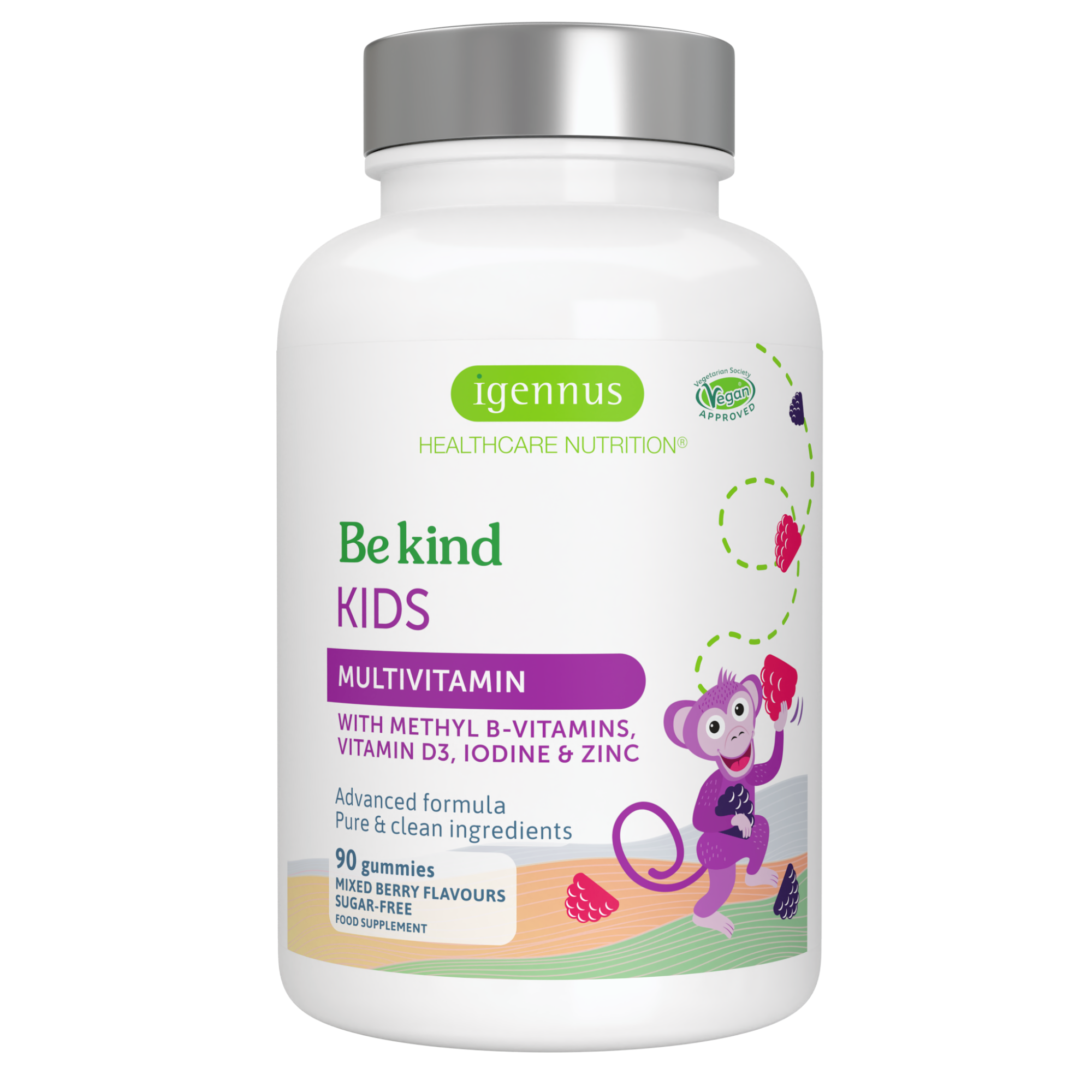If you’re feeling worried about your child’s reluctance to eat anything green or nutritious, you’re not the only one. So here’s the good news: kids don’t need to eat kale to be healthy. As a parent, it’s easy to fixate on specific foods, but instead we should be focusing on positive relationships with a diverse range of foods, to ensure optimal development.

As a nutritionist raising two fussy kids myself, I understand the challenges first-hand. Kids have strong minds of their own and personal preferences, but with the right knowledge, you can select foods based on their nutritional value for different areas of development. For instance, if your child’s diet is low in beta-carotene found in carrots, you can swap in dried apricots to ensure they get this essential nutrient. I have many tricks up my sleeve like this, which I will be sharing with you.
IS MY KID ACTUALLY FUSSY?
Of course we shouldn’t compare, but we always do. It’s rare to come across a child who will eat anything without hesitation, as it’s more typical for kids to be fussy. Children, like adults, have individual tastes and sensory perceptions, and often go through several picky-eating phases at some point in their development.
Sometimes eating behaviour can be interpreted as fussiness, when it is developmentally normal. A study looking at children who were perceived to be fussy by their mothers, found that there was no difference in food intake compared to children who were not perceived to be fussy. [1]
If your little one is very selective in their food choices, diversifying their diet may feel like an uphill battle; however it’s still achievable. At the end of the day, it doesn’t matter how fussy your child is, or what they currently like or dislike. It matters that you are there for them, helping to improve their eating habits.
WHY FOOD VARIETY MATTERS
When a child appears underweight, we worry; yet if a child looks healthy and consumes adequate calories, their well-being is often overlooked, even if most of their diet consists of cereal, bread and pasta. It's important to remember that children come in all shapes and sizes, influenced by genetic factors, and this doesn’t always reflect the healthiness of their diet.
Rather than fixating solely on weight, it’s more beneficial to concentrate on what they’re eating. Consider focusing on these three key areas of health and the necessary nutrients:
Bone & growth
To maximise a child’s growing potential, ensure adequate intake of calcium, magnesium, vitamin K, protein, iron, zinc and vitamin D.
Dairy products, including milk, yoghurt and cheese, provide calcium. Green leafy vegetables are particularly high in magnesium and vitamin K. Protein-rich foods including meat, beans and lentils are also good sources of iron, zinc and vitamin K. Eggs and dairy are other good sources of protein.
Although small amounts of vitamin D can be found in oily fish and eggs, this is not sufficient for optimal bone health. Vitamin D is primarily obtained through sun exposure to the skin in the spring and summer months. During the autumn and winter months in the UK, however, the sun is not strong enough. Supplementation is required at this time and is effective in increasing serum levels. [2]
Brain health
Omega-3 fatty acids play a key role in brain development and function, affecting behaviour, mood and learning ability. [3] Oily fish such as salmon and mackerel are rich sources of omega-3 and provide good levels when eaten twice a week. If your kid won’t eat fish on its own, try making salmon fish cakes dipped into their favourite sauce. If that fails, consider supplementing fish oils.
Many other nutrient-dense foods, including eggs, avocados and nuts & seeds are also powerhouses for providing nutrients for the brain.
Immune function
If your child is not eating much fruit or vegetables (relevant for most kids!) their immune system may not be functioning at its best.
To help fight off infections, focus on nutrients which support the immune system – these are often present in brightly coloured fruit and vegetables (such as peppers, carrots, mango, kiwi, broccoli and berries) so aim for a rainbow of colours each day. If this is hard to do, consider giving your child a multivitamin and mineral containing the antioxidants vitamins A, C and E.
Vitamin D is also important for immune health, so this doubles up to support both bone health and immune function. Vitamin D deficiency has been associated with increased likelihood of infection [4] and increased risk of childhood allergy and asthma. [5] There is a high prevalence of vitamin D deficiency in children worldwide, even in countries with low latitude [6] possibly due to children staying indoors more or the overuse of sunscreen.

SHOULD I PERSEVERE GIVING A SPECIFIC FOOD?
There are two very distinct views on how to encourage a child to eat a new food. On the one hand, health experts may advise that your child needs to try something 10-15 times until they will like or accept it. As a result of this advice though, some parents will tear their hair out while repeatedly cooking the exact same meal over and over, only to find their child refusing a single mouthful.
While this method of repeatedly introducing the same foods may, in theory, widen a child’s taste palate (if they eventually give in to eating the foods given), it doesn’t always work. Not only is this very frustrating for parents, but it can also result in mealtime anxiety and nutrient deficiencies. Pressuring a child to eat a specific food can result in reduced intake of this food in the long term [7], therefore this method may be counterproductive.
You may want to consider a gentler and more flexible approach; providing the same food but cooked in a different way and with varying textures. For example, if you are concerned that your child is not getting enough iron, and they refuse to eat chicken breast, it may be worth exploring other options such as blending chicken into a curry. Or maybe at this point in their life they hate the taste of chicken, but they love mincemeat.
Keep experimenting and vary appearances and textures of food, until your child becomes comfortable with eating it. There are always other ways to incorporate a food, or even try a different food with a similar nutritional value.
If your child is fussy about food textures, it’s fine to blend vegetable-based pasta sauces. If this is the only way to get vegetables into their diet at this moment in time, go for this option while at the same time slowly introducing vegetables cooked in different ways. As fussy eating phases are often temporary, it doesn’t hurt to attend to your child’s specific needs.
Getting them involved with growing fruits and vegetables, shopping in the supermarket, and food prep can also help to inspire your child to try them. This gentle repeated exposure to various food-based stimuli does not increase anxiety in children [8], therefore is an ideal approach if your child seems stressed at the dining table.
STARTING THE DAY RIGHT
Breakfast is usually the unhealthiest start to the day amongst kids, with cereal or toast being popular favourites, but devoid of nutrients (cereals are often fortified with poor forms of nutrients which are hard to absorb).
Try a few alternatives for breakfast including granola, or fresh fruit and yoghurt - adding a teaspoon of honey is fine if this will help your kids to eat it. You could even try baking healthy carrot cake or beetroot and chocolate muffins for a vegetable-filled start to the day. Empower your child by getting them involved with preparing food, chopping, stirring, and baking. This can really help to intrigue their young minds when it comes to making something a bit different.
Smoothies (also known as ‘monster juice’) are another great way to include more fruit and vegetables - e.g. blend a handful of spinach into a smoothie with ½ frozen banana, 1 cup of milk and 1 tsp. nut butter. Spinach is very nutritious and full of vitamin K, but as it contains oxalates, too much can inhibit absorption of other nutrients. To overcome this, it is ideal combined with cow’s milk in a smoothie, as calcium significantly reduces oxalate absorption. [9] A handful of spinach a couple of times a week combined with milk or another source of dairy is a good amount to have.
Another breakfast staple is nutritious porridge (but not the boring stuff made with chunky oats and water). You can also prepare big batches of porridge and freeze for another day.
How to make the perfect kid-friendly porridge (serves 2):
1. Select the best oats. Kids usually prefer rolled porridge oats which are cut into small pieces (rather than ‘whole’ or ‘jumbo’ rolled oats) as this produces a smoother texture.
2. Blend 1 cup of milk with 2 pieces of dried fruit (such as dates or dried apricots) and 1 portion of fruit or veg (e.g. 1 carrot, 1 apple or a handful of berries).
3. Add the wet blended mix to a pan with ½ cup of oats. Cook for 5 minutes on a low heat while stirring.
4. Add a pinch of cinnamon to taste (if your child likes this!)

DO KIDS NEED SNACKS?
To snack or not to snack? The government’s advice given to parents of young children is to snack 2-3 times per day between meals.
While some thrive on snacks when they are growing fast, others who are incredibly fussy may end up skipping on their main cooked meals. If your child is relying on snacks as their main source of food, try to avoid snacks within 1-2 hours before mealtimes to ensure they have an appetite.
You can also upgrade snacks to a healthier option. Rather than trying to replace crisps with sliced cucumber, start with something more realistic to achieve. For example, you could add houmous or tzatziki (yoghurt & cucumber dip) to have alongside crisps to widen their food choices or opt for mixed vegetable crisps made from beetroot and carrot. Remember the three areas of health to focus on and try to opt for a food which will benefit their health, such as yoghurt for bone health.
When selecting ready-made snacks in the shops, don’t just choose these based on the healthy-looking packaging. Take time to read the ingredients list as they can vary considerably. Vegetable puffs, for example, can be made from 80% corn vs. lentils, which have very different amounts of protein and fibre.
SAVE TIME WITH BATCH COOKING & SIMPLE MEALS
No parent wants to spend hours in the kitchen each evening only to watch their child grimace or outright refuse to even taste your lovingly prepared offering. Batch cooking a few of their known favourite meals is therefore a must, to keep your sanity while trying to introduce new healthy foods. Whip up a large batch and store in portion sizes in the freezer (e.g. pasta, chilli con carne).
If your child has 4 dinners each week from such pre-cooked meals, you know that they are getting a decent amount of nutrients on these days. The other 3 evenings, you may want to mix things up a bit by adding new foods. What you don’t want to do is give yourself the frustrating task of creating perfectly balanced nutritious meals each night, which are most likely going to be refused.
We also must be realistic that not every meal will be cooked from scratch. If you are a busy parent, ensure you have a couple of quick options ready to go to. While oven-cooked chips are not the most nutritious fast-food option, there are others which will at least provide protein and fibre, such as fish fingers with baked beans. Remember, we are not striving for perfection here but simply an improvement on what they are eating now. If your child will currently only eat chips for dinner, these simple swaps are a big step in the right direction; celebrate these victories and progress along the way.
THE IDEAL MEAL ENVIRONMENT
From distraction techniques, to telling your child they will gain superpowers from a food, there’s a lot you can try to encourage your kid to eat certain meals. The way you serve a meal, and the environment, also significantly affects how much they will eat.
A relaxed setting for eating may help to reduce stress and anxiety, therefore a child may be more open to try new foods. Mealtime routines with parents choosing the food that is served (and free from TV) has been shown to lower odds of picky eating. [10] On the other hand, negative techniques including food as punishment and inconsistent parenting can exacerbate picky eating habits. [11]
A common issue with mealtimes is that families often don’t eat together, understandably, as it’s not always practical to fit into your schedules. Parents’ habits can also influence a child’s eating behaviour; fussy eating parents frequently have children who accept fewer food items and eat unhealthier foods. [12] It’s important to be aware of what and how you eat in front of your children, or any comments you make around food.
Kids like to mimic the behaviour of others around them, so if they are eating on their own, it’s very hard for them to feel comfortable to eat new foods. If a child has siblings, parent, or carer to eat with, this is ideal. If your child eats at 4pm for example, but you eat much later, try serving yourself the same meal they are having in a very small portion - consider it your starter.

DO KIDS NEED A MULTIVITAMIN?
Not every child needs to take a multivitamin, although most would benefit from one. If you think your child is missing out on key nutrients for their development, a supplement is a great way to top up their nutrients while they are on that journey to better eating. For picky eating children with a risk of malnutrition, nutritional supplements have shown to promote catch-up growth [13] and improve cognitive function, including memory. [14]
Navigating the world of children’s nutrition can be tough, but multivitamin nutrient labels can easily be compared. There’s a wide range of kids supplements to choose from, but many only provide 3-4 nutrients, only serving their purpose for very basic needs.
If you are seeking a comprehensive multivitamin, Be kind Kids Multivitamin provides 11 key vitamins and minerals for children aged 4+ in delicious berry flavour gummies - ideal for fussy eaters who may not be getting all of these from their diet. Most importantly it provides these nutrients in their absorbable forms, e.g. B12 as methylcobalamin, and at adequate doses. The gummies are free from unnecessary ingredients including sugar and artificial sweeteners, and made with real fruit powder, natural colours and flavours.
SUMMARY
At the end of the day, there is not a magic bullet to solve all your worries with a fussy eater. Try to approach your child’s nutrition in a holistic way; offer food variety, involve your little darling as much as possible with food prep, and provide a relaxed and structured eating environment. Also remember that it’s fine to tend to your child’s individual needs, considering presentation or textures of certain foods – do what works for them. Lastly, top up your child’s nutrient intake with a multivitamin, and ensure they get adequate sun exposure in the spring and summer months.
References
1. Byrne R, Jansen E, Daniels L. Perceived fussy eating in Australian children at 14 months of age and subsequent use of maternal feeding practices at 2 years. Int J Behav Nutr Phys Act. 2017 Sep 11;14(1):123. doi: 10.1186/s12966-017-0582-z. PMID: 28893283; PMCID: PMC5594597.
2. Joh HK, Hwang SS, Cho B, Lim CS, Jung SE. Effect of sun exposure versus oral vitamin D supplementation on serum 25-hydroxyvitamin D concentrations in young adults: A randomized clinical trial. Clin Nutr. 2020 Mar;39(3):727-736. doi: 10.1016/j.clnu.2019.03.021. Epub 2019 Mar 21. PMID: 30987813.
3. DiNicolantonio JJ, O'Keefe JH. The Importance of Marine Omega-3s for Brain Development and the Prevention and Treatment of Behavior, Mood, and Other Brain Disorders. Nutrients. 2020 Aug 4;12(8):2333. doi: 10.3390/nu12082333. PMID: 32759851; PMCID: PMC7468918.
4. McArdle AJ, Keane D, Seddon JA, Bernatoniene J, Paton J, McMaster P, Williams A, Williams B, Kampmann B. Vitamin D deficiency is associated with tuberculosis disease in British children. Int J Tuberc Lung Dis. 2020 Aug 1;24(8):782-788. doi: 10.5588/ijtld.19.0626. PMID: 32912382.
5. Hollams EM, Teo SM, Kusel M, Holt BJ, Holt KE, Inouye M, De Klerk NH, Zhang G, Sly PD, Hart PH, Holt PG. Vitamin D over the first decade and susceptibility to childhood allergy and asthma. J Allergy Clin Immunol. 2017 Feb;139(2):472-481.e9. doi: 10.1016/j.jaci.2016.07.032. Epub 2016 Oct 7. PMID: 27726947.
6. Palacios C, Gonzalez L. Is vitamin D deficiency a major global public health problem? J Steroid Biochem Mol Biol. 2014 Oct;144 Pt A:138-45. doi: 10.1016/j.jsbmb.2013.11.003. Epub 2013 Nov 12. PMID: 24239505; PMCID: PMC4018438.
7. Jansen PW, de Barse LM, Jaddoe VWV, Verhulst FC, Franco OH, Tiemeier H. Bi-directional associations between child fussy eating and parents' pressure to eat: Who influences whom? Physiol Behav. 2017 Jul 1;176:101-106. doi: 10.1016/j.physbeh.2017.02.015. Epub 2017 Feb 16. PMID: 28215424; PMCID: PMC5436628.
8. Thorsteinsdottir S, Olafsdottir AS, Traustadottir OU, Njardvik U. Changes in Anxiety following Taste Education Intervention: Fussy Eating Children with and without Neurodevelopmental Disorders. Nutrients. 2023 Nov 15;15(22):4783. doi: 10.3390/nu15224783. PMID: 38004177; PMCID: PMC10675003.
9. von Unruh GE, Voss S, Sauerbruch T, Hesse A. Dependence of oxalate absorption on the daily calcium intake. J Am Soc Nephrol. 2004 Jun;15(6):1567-73. doi: 10.1097/01.asn.0000127864.26968.7f. PMID: 15153567.
10. Cole NC, Musaad SM, Lee SY, Donovan SM; STRONG Kids Team. Home feeding environment and picky eating behavior in preschool-aged children: A prospective analysis. Eat Behav. 2018 Aug;30:76-82. doi: 10.1016/j.eatbeh.2018.06.003. Epub 2018 Jun 7. PMID: 29894927.
11. Leuba AL, Meyer AH, Kakebeeke TH, Stülb K, Arhab A, Zysset AE, Leeger-Aschmann CS, Schmutz EA, Kriemler S, Jenni OG, Puder JJ, Munsch S, Messerli-Bürgy N. The relationship of parenting style and eating behavior in preschool children. BMC Psychol. 2022 Nov 22;10(1):275. doi: 10.1186/s40359-022-00981-8. PMID: 36419113; PMCID: PMC9682652.
12. Thorsteinsdottir S, Olsen A, Olafsdottir AS. Fussy Eating among Children and Their Parents: Associations in Parent-Child Dyads, in a Sample of Children with and without Neurodevelopmental Disorders. Nutrients. 2021 Jun 25;13(7):2196. doi: 10.3390/nu13072196. PMID: 34202394; PMCID: PMC8308294.
13. Khanna D, Yalawar M, Saibaba PV, Bhatnagar S, Ghosh A, Jog P, Khadilkar AV, Kishore B, Paruchuri AK, Pote PD, Mandyam RD, Shinde S, Shah A, Huynh DTT. Oral Nutritional Supplementation Improves Growth in Children at Malnutrition Risk and with Picky Eating Behaviors. Nutrients. 2021 Oct 14;13(10):3590. doi: 10.3390/nu13103590. PMID: 34684591; PMCID: PMC8538528.
14. Roberts SB, Franceschini MA, Silver RE, Taylor SF, de Sa AB, Có R, Sonco A, Krauss A, Taetzsch A, Webb P, Das SK, Chen CY, Rogers BL, Saltzman E, Lin PY, Schlossman N, Pruzensky W, Balé C, Chui KKH, Muentener P. Effects of food supplementation on cognitive function, cerebral blood flow, and nutritional status in young children at risk of undernutrition: randomized controlled trial. BMJ. 2020 Jul 22;370:m2397. doi: 10.1136/bmj.m2397. PMID: 32699176; PMCID: PMC7374799.









